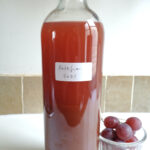
Ratafia
Ratafia is an apéritif that is served across much of rural France but is rarely encountered in Paris. The reason? It is generally brewed at country homes. Making it is easy — you crush some grapes, filter the juice, add a glass of strong alcohol and let the mixture sit. Then you add a little sugar, wait a bit more, refilter the juice — and enjoy.
Ratafia can be made with blue or red grapes, which produce a cl0udy red apéritif, as shown above, or with green grapes, which produce a golden apéritif. Choose a variety that’s high in sugar content. No need for seedless grapes — the seeds will be filtered out.
The alcohol of choice would be one distilled from the skins and pulp of grapes leftover from winemaking, such as grappa or, in France, marc de Bourgogne. Another possibility is vodka, providing it’s the clear, unflavored variety.
The quantities below will make enough ratafia to fill one empty wine bottle. The ratafia will keep for about a year. Serve it at cocktail hour, chilled or over ice.
2-1/2 pounds (1 kilo) grapes, or enough to make 3 cups (750 ml) of juice
1 cup (250 ml) grappa, vodka or marc de Bourgogne
1/2 cup (200 g) sugar
Rinse the grapes and strip them from their stems. Place them in a food processor or, if using a hand-held blender to crush them, in a large bowl.
Crush the grapes, extracting as much juice as possible. Pour the juice through a sieve into a recipient. Measure out 3 cups (750 ml) of juice and transfer it to a clean jar. Add the alcohol. Shake, seal the jar and store it in a dark place, like a cupboard.
Wait three weeks.
Open the jar, add the sugar and shake. Let it rest and shake again. Repeat until all the sugar dissolves. Return the jar to its cool, dark place.
Wait one week.
 Refilter the ratafia into a bowl through a fine sieve or a cheesecloth. Then pour it through a funnel into a clean wine bottle. Cork or cap.
Refilter the ratafia into a bowl through a fine sieve or a cheesecloth. Then pour it through a funnel into a clean wine bottle. Cork or cap.
The ratafia is now ready. It may be served as an apéritif at cocktail hour or as a fortified wine to accompany melon, cured ham, foie gras, blue cheese or Roquefort. It also goes well with desserts.




